|


| |
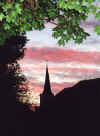 |
Erfurt, "city of spires," is where Martin
Luther studied at university (1501-1505), entered the Augustinian
monastery (July 17, 1505), and was ordained a priest (April 1507). Photo A
is Nicholas tower–the only remaining part of this fourteenth century
building. |
Facts and Photos
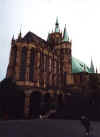 James
Kittelson says of Erfurt: "Erfurt was a city of hills, woods, streams, and
the spires of many churches, including a cathedral that rose up out of the
tallest hill and presided over all like a brooding citadel. Nothing could convey
the awe and majesty of God with such force as did this great, stone presence.
Churchgoers had to climb a great pile of stone steps just to reach it from the
city below" (44). In this towering cathedral (Photo B) Luther was
ordained a priest. James
Kittelson says of Erfurt: "Erfurt was a city of hills, woods, streams, and
the spires of many churches, including a cathedral that rose up out of the
tallest hill and presided over all like a brooding citadel. Nothing could convey
the awe and majesty of God with such force as did this great, stone presence.
Churchgoers had to climb a great pile of stone steps just to reach it from the
city below" (44). In this towering cathedral (Photo B) Luther was
ordained a priest.
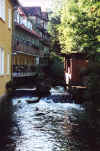 The city is still one of breathtaking beauty with the towering church spires
over head and the rippling waters of the Gera River flowing at one's feet (photo
C). The city is still one of breathtaking beauty with the towering church spires
over head and the rippling waters of the Gera River flowing at one's feet (photo
C).
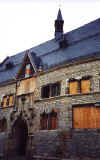 Luther
arrived in 1501 to study at the University of Erfurt, founded in 1392. Photo D
is the newly-reconstructed entrance of the former university, which closed in
1816. Luther completed his bachelor of arts in the minimum time allowed, one
year, and finished the master of arts in two years, graduating second his class
of seventeen. He was registered to study law until his thunderstorm experience
and vow to St. Ann changed the direction of his life in 1505. Luther
arrived in 1501 to study at the University of Erfurt, founded in 1392. Photo D
is the newly-reconstructed entrance of the former university, which closed in
1816. Luther completed his bachelor of arts in the minimum time allowed, one
year, and finished the master of arts in two years, graduating second his class
of seventeen. He was registered to study law until his thunderstorm experience
and vow to St. Ann changed the direction of his life in 1505.
Luther had many options for monastic life in Erfurt–there were eleven
monasteries, among them the Dominicans, the Franciscans, the Benedictines, and
the Augustinian Eremites or Hermits whom Luther joined (not to be confused with
the Augustinian Canons, who were in another part of the city). Although the
Augustinian Hermits were a mendicant (begging) order, the Black Cloister at the
time of Luther was well-endowed and the monks has leisure for study.
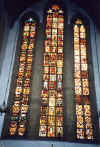 Construction
on the church began in 1291 and was completed in the mid-fourteenth century. The
valuable choir windows in the front, depicting the life of Christ, date from the
fourteenth century (Photo E). The side window, facing north, shows the life of
St. Augustine of Hippo (354-430), whose monastic rule the order followed. All
the valuable windows were removed during World War II. According to the custom
of the time, former abbots were buried in the chancel or choir of the church. As
part of the monastic ritual for his final vows, Luther laid prostrate on top of
the grave of Abbot Johannes Zacharias, who attended the Council of Constance
(1414-1418) and was a leader of those who condemned John Huss and had him burned
at the stake for heresy. In this church Luther celebrated his first mass on May
2, 1507 in the presence of his father. Construction
on the church began in 1291 and was completed in the mid-fourteenth century. The
valuable choir windows in the front, depicting the life of Christ, date from the
fourteenth century (Photo E). The side window, facing north, shows the life of
St. Augustine of Hippo (354-430), whose monastic rule the order followed. All
the valuable windows were removed during World War II. According to the custom
of the time, former abbots were buried in the chancel or choir of the church. As
part of the monastic ritual for his final vows, Luther laid prostrate on top of
the grave of Abbot Johannes Zacharias, who attended the Council of Constance
(1414-1418) and was a leader of those who condemned John Huss and had him burned
at the stake for heresy. In this church Luther celebrated his first mass on May
2, 1507 in the presence of his father.
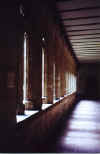 |
After prayer seven times each day, the monks would exit a
door in the church and enter the Kreuzweg, the way of the cross. The
walkway (photo F) looks out on the open courtyard, the burial ground for
the monks. On the other side is the chapter hall (now converted into
a small chapel, photo G), where the monks would meet weekly for the public
reading of the rule, to receive the abbot's instruction, and for public
reprimands of the erring monks. |
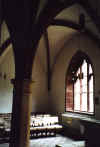 |
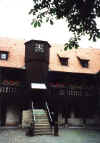 The
oldest part of the monastery is the guest house or hospice (photo H). Luther
stayed here for several weeks when he initially entered the monastery until he
was formally accepted into the novitiate. His father also stayed in the guest
house when he came for son Martin's first mass. The
oldest part of the monastery is the guest house or hospice (photo H). Luther
stayed here for several weeks when he initially entered the monastery until he
was formally accepted into the novitiate. His father also stayed in the guest
house when he came for son Martin's first mass.
Reflections
On Monday mornings our German instructor, Iris, would greet us with this
question: "Was hast du am Wochende gemacht?" (What did you do on the
weekend?) I carefully thought through the proper grammar and when my turn came,
I replied, "Ich habe geschlafen, wo Martin Luther geschlafen hatte."
(I've slept where Martin Luther had slept.) When the five of us (my parents,
Richard and Miriam Carter and me) visited Erfurt, we learned that the
Augustinian cloister rents rooms in the old guest house (58 DM–about $29–per
night for a single room, shared bath, and breakfast). I vowed to return and stay
there for a number of reasons. It is an incredibly beautiful city, there's so
much to see, I would have my own set of keys to the cloister throughout the
weekend, and there is also a group of evangelische Schwestern (Protestant
sisters or nuns) who follow the Rule of Benedict, living and praying in the
cloister four times each day. The small group of seven sisters was very
hospitable; during the weekend I joined them for each of their four prayer times
at least once, sitting with them in the choir stalls where Luther prayed daily.
It was near the end of my time in Germany, when my German was about at its best,
so praying the Psalms and singing hymns in German was quite meaningful. I still
couldn't understand most of normal conversations outside of class, but with the
written text in front of me, with familiar vocabulary and context, my
comprehension of the language was pretty good. At the Sunday divine service, we
(I met some friends in Erfurt for the weekend who were on a Bach tour) were
invited to come and sit in the choir also, although some of the congregation
remained seated in the nave of the church. The liturgy was done with care and
reverence, and I felt very much at home. After the divine service, the sisters
continued with their service of hospitality, offering coffee to the worshipers
in the small café operated by the cloister. The beautiful city, the
contemplative setting of the cloister so intimately related to the Luther, the
hospitality of the sisters based on the Benedictine tradition of work and prayer
that I have grown to appreciate–all these combined to make my stay there a
wonderful experience. I was nearly ready to sign up and join the group
permanently!
|
